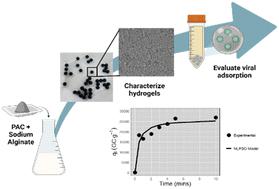Development of a powdered activated charcoal sodium alginate hydrogel bead concentration method for detecting viruses in wastewater
IF 4.3
3区 材料科学
Q1 ENGINEERING, ELECTRICAL & ELECTRONIC
引用次数: 0
Abstract
Existing techniques for concentrating viruses from wastewater are often time consuming, costly, and usually involve cumbersome laboratory methods, limiting their practical application for routine use. As such, the need for simpler concentration methods that do not forfeit efficacy are crucial for permitting more accessible detection of viruses from wastewater. This study introduces a rapid concentration method using powdered activated charcoal sodium alginate (PAC-NaA) hydrogel beads, optimized for capturing viruses from wastewater. Through scanning electron microscopy and bench-scale experiments, we optimized hydrogel bead formulation and identified a Tween®20-based buffer as the most effective elution buffer for recovering SARS-CoV-2 from the hydrogel beads. Kinetic adsorption parameters were also evaluated, establishing a 5 min exposure duration for maximum viral recovery. Model fitting of the experimental data indicated that the adsorption process adheres to a non-linear pseudo-second-order model, indicative of physiochemical adsorption mechanisms likely facilitating viral capturing from wastewater. Additionally, successful detection of endogenous SARS-CoV-2 and Adenovirus was achieved using the PAC-NaA hydrogel concentration method. The advantages of this approach lie in its adaptability and simplicity, as hydrogel beads can be modified to enhance viral adsorption efficiency in various environmental contexts.

开发用于检测废水中病毒的粉末活性炭海藻酸钠水凝胶珠浓缩法
从废水中浓缩病毒的现有技术通常耗时长、成本高,而且通常涉及繁琐的实验室方法,限制了其在日常应用中的实际应用。因此,要想更方便地检测废水中的病毒,就必须采用更简单的浓缩方法,而这种方法又不会丧失功效。本研究介绍了一种使用粉末状活性炭海藻酸钠(PAC-NaA)水凝胶珠的快速浓缩方法,该方法针对捕获废水中的病毒进行了优化。通过扫描电子显微镜和台架实验,我们优化了水凝胶珠的配方,并确定基于 Tween®20 的缓冲液是从水凝胶珠中回收 SARS-CoV-2 的最有效洗脱缓冲液。同时还对动力学吸附参数进行了评估,确定了 5 分钟的暴露持续时间为最大病毒回收率。实验数据的模型拟合表明,吸附过程遵循非线性伪二阶模型,这表明生化吸附机制可能有助于从废水中捕获病毒。此外,利用 PAC-NaA 水凝胶浓缩法成功检测了内源性 SARS-CoV-2 和腺病毒。这种方法的优势在于其适应性和简便性,因为水凝胶珠可以进行改性,以提高在各种环境条件下的病毒吸附效率。
本文章由计算机程序翻译,如有差异,请以英文原文为准。
求助全文
约1分钟内获得全文
求助全文

 求助内容:
求助内容: 应助结果提醒方式:
应助结果提醒方式:


